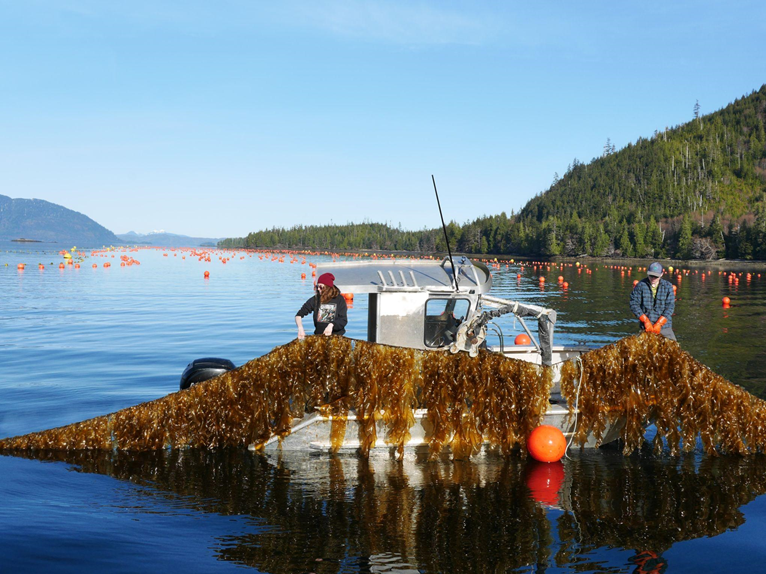The increasing demand for American-grown seafood and improved technology to farm in the open ocean provides incentive for aquaculture expansion. A recent step toward domestic aquaculture development was the Presidential Executive Order Promoting American Seafood Competitiveness and Economic Growth issued in May 2020, which designated NOAA as the lead agency to support the identification of 10 Aquaculture Opportunity Areas (AOAs) in various regions of the U.S. An AOA is a small defined geographic area that has been evaluated to determine its potential suitability for commercial aquaculture.
To support the E.O. requirement to identify AOAs, NOAA’s National Centers for Coastal Ocean Science collaborated with NOAA’s National Marine Fisheries Service to initiate a mapping and modeling study to identify potential AOA options in federal waters. In 2021, NOAA published the first round of AOA atlases using a combination of scientific analysis and public engagement to identify potential areas that are environmentally, socially, and economically appropriate for commercial aquaculture in the U.S. Gulf of America (formerly the U.S. Gulf of Mexico) and Southern California Bight.
For round 2, NOAA and the State of Alaska are collaborating to identify Aquaculture Opportunity Areas (AOAs) in Alaska’s waters, focusing on sustainable shellfish and seaweed aquaculture. Through comprehensive spatial analysis and robust stakeholder engagement, these AOAs will foster responsible aquaculture development that supports local communities while minimizing potential impacts to surrounding ecosystems.

Why We Care
Seafood farming, if done responsibly — as it is in the U.S. — is increasingly recognized as one of the most environmentally sustainable ways to produce food and protein. Marine aquaculture is a resource-efficient method of increasing and diversifying U.S. seafood production that can expand and stabilize U.S. seafood supply in the face of environmental change and economic uncertainty.
The global human population is rising, but the global abundance of wild fish is not. NOAA Fisheries and its partners have made good progress toward ending overfishing in the United States through sound, science-based management practices, but wild fish harvests cannot meet current seafood demands. By expanding seafood farming we can ensure a safe, secure, and sustainable local seafood supply.
The U.S. currently has a $20 billion national seafood trade deficit. With a coastline longer than the lower 48 states combined, Alaska holds tremendous potential for aquaculture and working waterfronts.
What We Are Doing
In June 2023, NOAA and the state of Alaska announced a collaborative effort to identify Aquaculture Opportunity Areas (AOAs) in Alaska’s waters, focusing on sustainable shellfish and seaweed aquaculture. Through advanced analysis and stakeholder input, these AOAs will foster responsible aquaculture that balances environmental, economic, and cultural considerations.
In October 2023, NOAA announced the next phase of this process — a request for data, analysis, and information from the public to aid in the identification of AOAs in Alaska state waters as part of a 60-day comment period.
In April 2025, NOAA announced another opportunity to gather public comment on the draft AOA options in a Notice of Availability. This report outlines NCCOS’ whole-ecosystem spatial modeling approach and highlights the extensive stakeholder engagement.
Benefits of Our Work
Identifying AOAs marks a proactive step toward sustainable aquaculture development. By employing science-based methodologies and engaging stakeholders, these areas will complement wild-capture fisheries, contribute to ecosystem health, and support the growth of our domestic seafood industry.
- The atlases will be used by natural resource managers, industry, regulators, and coastal planners to develop and expand aquaculture in the U.S. Exclusive Economic Zone (EEZ).
- Spatial modeling allows planners to identify areas where interactions between protected species and habitats and aquaculture operations may be avoided and minimized.
- By employing science-backed methodologies, we’re ensuring the “triple bottom line” of environmental conservation, economic growth, and social well-being.
- Incorporating Traditional Ecological Knowledge from Alaska Natives, tribes, and the local community ensures that planning efforts will invigorate Alaska’s aquaculture sector while preserving its unique natural and cultural resources.
- This is the first step in creating a coordinated, comprehensive, streamlined permitting system for aquaculture development in the U.S. EEZ.
Next Steps
Public insights and feedback are invaluable. NOAA is seeking public input to shape the future of aquaculture in Alaska state waters. More information can be found here in this FAQ. Submit your comments on the draft AOA options here.
It is important to note that identifying potential Aquaculture Opportunity Areas does not designate an AOA, but is instead an important step to provide peer-reviewed mapping that informs the site selection process. Following the results of this study, NOAA Fisheries will host a public comment period and will coordinate discussions with regional and national stakeholders. The decision to identify an AOA will only be made after completion of the National Environmental Policy Act (NEPA) process and consideration of the information presented in a Programmatic Environmental Impact Statement (PEIS).
AOAs atlases have been completed for the Southern California Bight and the U.S. Gulf of America (formerly the U.S. Gulf of Mexico) (2021), and NOAA Fisheries is currently undergoing the NEPA and PEIS processes for these regions. In the coming years, additional Aquaculture Opportunity Areas will be identified around the nation.
